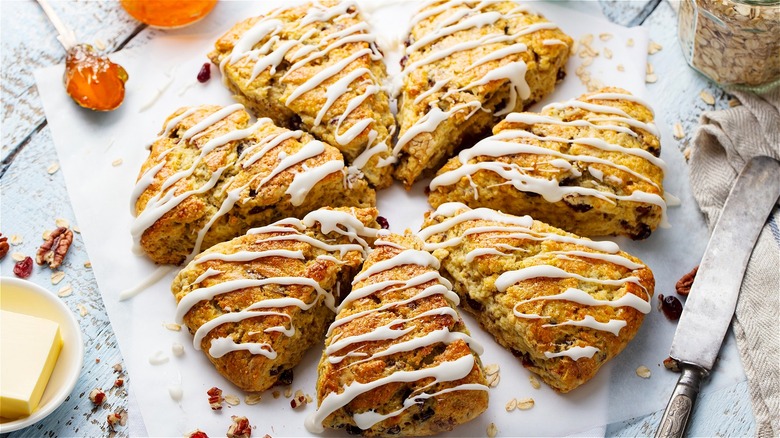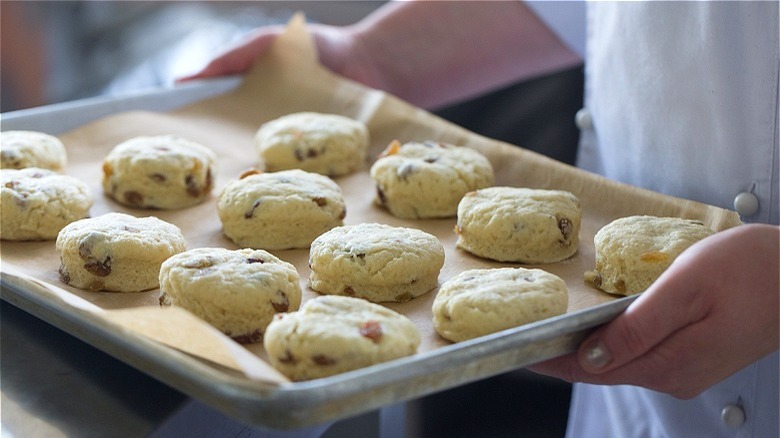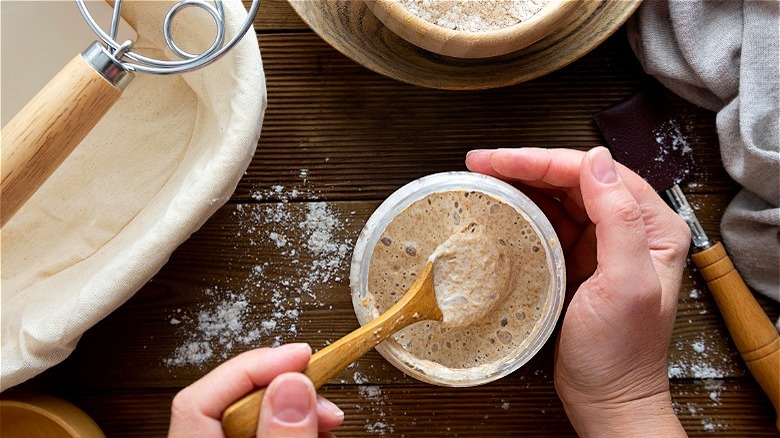Elevate Your Next Batch Of Scones With Some Sourdough Starter
Who doesn't enjoy a warm, flaky scone to go with that early-morning cup of coffee? The Sturgis Journal notes that scones originated in Scotland in the 1500s and later grew in popularity in England in the 18th century. But this delicate baked good is also becoming quite popular in the United States, thanks to the adoption of the European treat by countless coffee shops around the country.
Whether you prefer blueberry lemon scones or a more savory assortment such as cheddar herb scones, most varieties follow a standard recipe base, as in America's Test Kitchen's recipe for simple cream scones, which includes flour, sugar, salt, baking powder, heavy cream, and butter.
While MasterClass categorizes scones as a basic quick bread, there are ways you can elevate any basic scone such as using frozen butter to assure prime flakiness or chilling your dough before baking to prevent your scones from losing their shape. To add additional flavor, King Arthur Baking Company suggests adding a crunchy topping, such as cinnamon sugar, with egg wash. If you want to try something new apart from a simple addition of blueberries or cinnamon sugar, you may want to consider adding some sourdough discard to your scone batter.
How to make sourdough scones
The one tip to follow when making sourdough pasta has everything to do with sourdough discard. But pasta isn't the only food your leftover sourdough starter can upgrade. If you're a scone aficionado, you've probably tried adding walnuts and even cheddar. But sourdough discard will give your scones a distinct flavor unlike any other.
MasterClass outlines how to make tangy sourdough scones, and the best part is that the process is very similar to any standard scone recipe. The difference lies in the addition of sourdough discard and a short 15-minute rest in your refrigerator before baking.
If you want to elevate your scones even more by making them with fermented flour, Farmhouse On Boone provides two alternatives. First, after mixing together your sourdough scones, simply place your dough covered in the refrigerator and leave it there for up to three days. Or, you can premix your flour, sugar, salt, and butter, mix in your cream and starter, and leave it on the counter for up to 12 hours before mixing in the egg and leavening agent. If you're looking for a simple way to intensify the flavor of your beloved scone recipe, the short-form process may be your best bet. However, if you want a nuanced flavor and better digestibility, consider the long fermentation method.
What is sourdough discard?
According to the WebstaurantStore blog, sourdough starter is homemade wild yeast composed of water and fermented flour that naturally causes baked goods to rise when added at the right time in the baking process. And if you make sourdough, you already know how warm water can reveal if your starter is ready for action. Wild yeast needs to be fed often to stay alive, and Cultures For Health says this feeding process produces ethanol and carbon dioxide, which creates air pockets in the starter itself.
Yet over time, if none of this precious mixture is thrown away before the next feeding, you may end up with an overload of sourdough starter that even the most efficient at-home baker would find overwhelming. Defined as sourdough discard, The Clever Carrot describes how this semi-dormant portion of your starter may not be bubbly enough to make bread rise, but sourdough discard is still a beneficial food worth adding to certain baked goods.
Cultures For Heath outlines how you can use sourdough discard to enhance the flavor of any baked good with or without additional flour. You can also take the process a step further and allow the discard to ferment your flour-based recipes for a period of at least 12 hours, which will break down the gluten further and mimic more of a true sourdough recipe.


